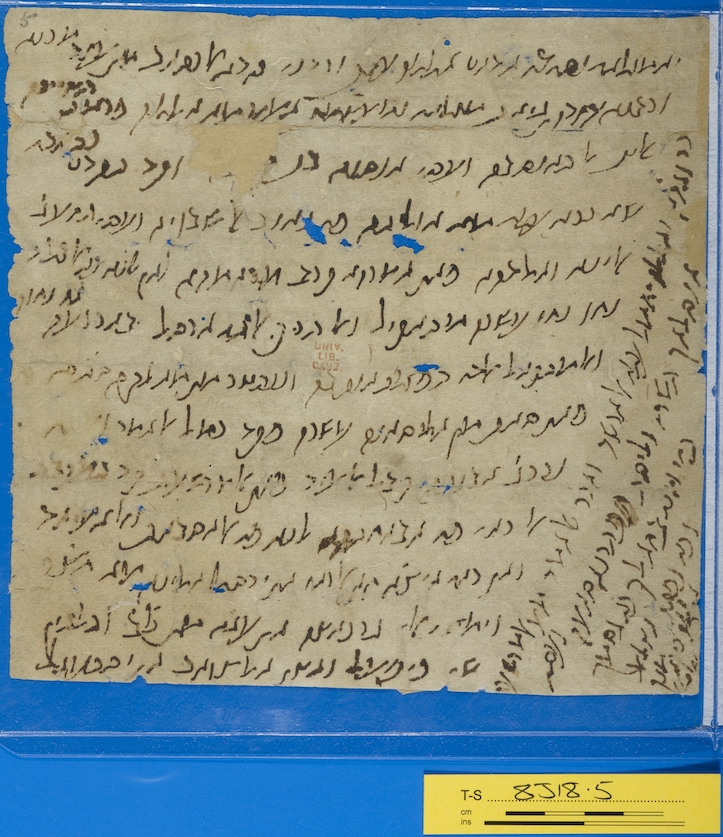Q&A Wednesday: José Martínez Delgado and the letters of al-Andalus

Pepe, what are you working on at the moment?
As always, I’m dealing with grammatical issues, working with the book of Hayyuj, on the study of the transmission of Biblical Hebrew in al-Andalus. But not just that, these days! I started working on grammatical texts in the Genizah back in 2007, but I came to recognise an impediment to many Genizah researchers – we only work on our ‘own’ topics. After I met Nadia Vidro, she introduced me to the world of the Karaites, and Amir Ashur opened up the world of al-Andalus. I realised that, although I deal with grammarians, the grammarians were people. They have a life and I would like to know about that life. I began to read the letters of their community, and found myself immersed in a time capsule – in a place where time hasn’t passed since the 11th century. I went looking for grammarians, but found al-Andalus as it once was. I feel like I was looking for a donkey but found a crown.
Can you tell us about some of the documents you’ve been reading?
Each letter is like a stamp of the moment. In one (T-S 8J18.5), Judah ha-Levi is trying to arrange the release of a young slave girl. He writes that they don’t let her come with us on holidays and weekends. And you think, What?! She’s a slave who’s going to be sold, and she might come back on weekends? Is she a part-time slave? You start to realise you have no idea about the medieval world. Every letter turns up new questions. I want to translate these letters for readers, but I have more questions than the reader after I translate the text. There’s always a surprise.
What are your plans for these documents?
Amir Ashur and I have just completed a book, in Spanish, which is in press at the moment, containing 22 manuscripts from the Cambridge Genizah collections that reveal daily life in al-Andalus. The 22 documents – one for each letter of the Hebrew alphabet – include those of famous individuals like Judah ha-Levi and Maimonides, as well communal letters.
Do the letters encompass a certain time period?
The letters are from the 10th to 12th centuries – the pinnacle of the splendour of al-Andalus before the invasion of the Almohads. We focused on these centuries because little is known of the Jews at this time. You can come to Spain and see the Mosque, the Alhambra, the castles. But if you ask to see a synagogue, the first one is from the 13th century, after Cordoba was conquered by the Christians. Nothing is known of the Jews of al-Andalus, but these documents. I think there’s nothing better to explain daily life, so we let them talk. We have translated them in order to spread this treasure to Spanish speakers everywhere. It’s not a book about history – it’s history itself. And we hope people will hear.
It sounds like your collaboration with Amir was very fruitful.
The great thing about working with Amir is that if I don’t know something, he does, and if he doesn’t know it, I do. We are the perfect couple. This is what I recommend – find someone else as crazy as you who can help you with a task. I was immersed in my grammar and he opened my eyes to a different world. There’s been a certain amount of personal development as well, as now I can read the documents too. The book is written for the general public. This was the most difficult task – to make it accessible to everyone. For some of the documents, it was the first time they were edited, and for all, it’s the first time they were translated into Spanish.
Was it particularly important to you to publish this book in Spanish?
It’s important for several reasons. Firstly, it’s something that happened here, so people here should know about it. Secondly, because scholars need to start to fix the terminology in Spanish. Terms are fixed in English and Hebrew, but not yet in Spanish. I eventually hope to compile all the Genizah documents relating to the Jews of al-Andalus.
Thanks very much, Pepe. We are looking forward to seeing the book in print.
La Vida Cotidiana de los judíos de Alandalús (siglos x-xii): Antología de manuscritos de la Guenizá de El Cairo (University of Cambridge), by José Martínez Delgado and Amir Ashur (UCOPress Universidad de Cordoba: 2021) will be available soon at the publisher's website.


Add new comment